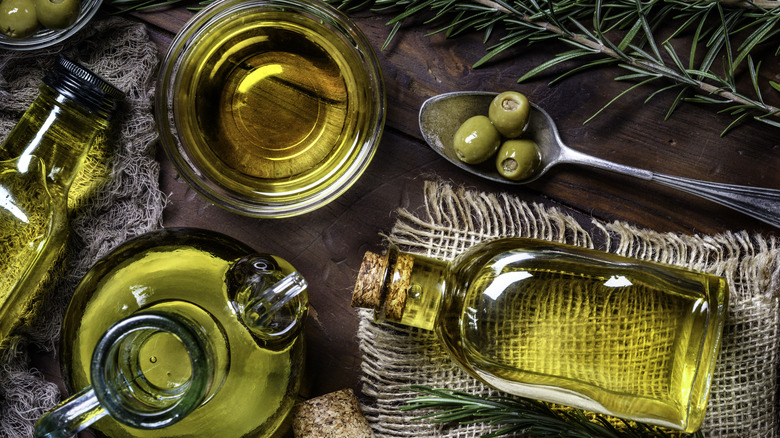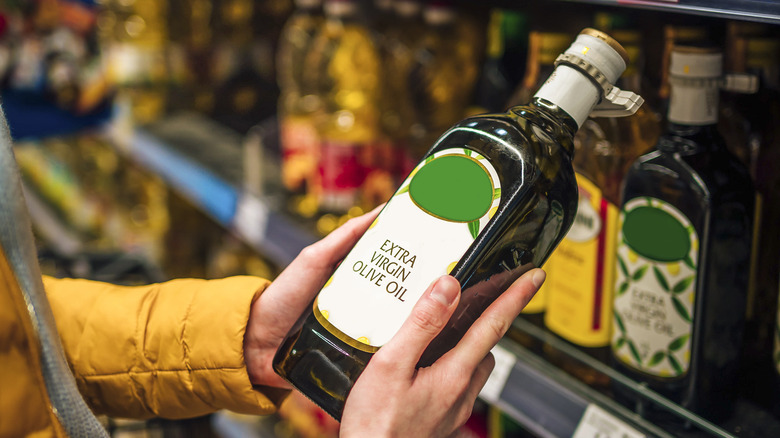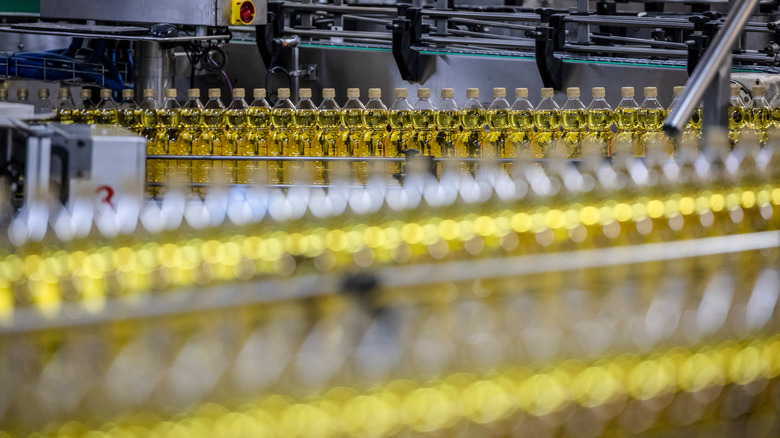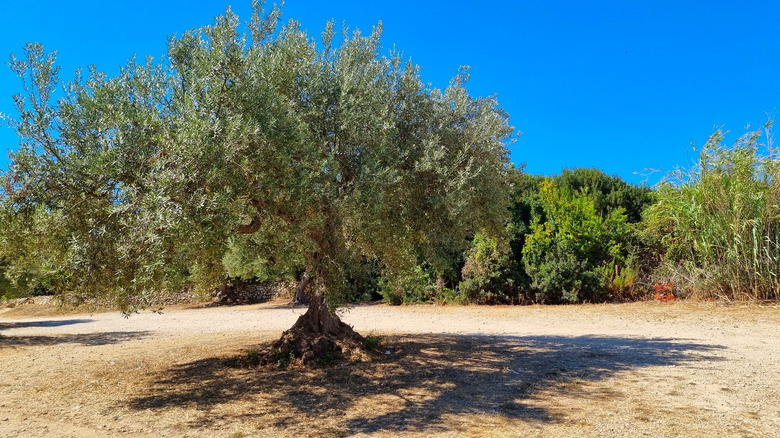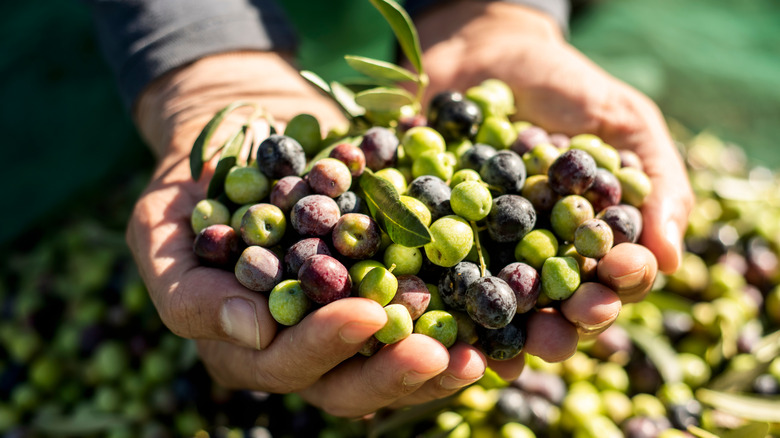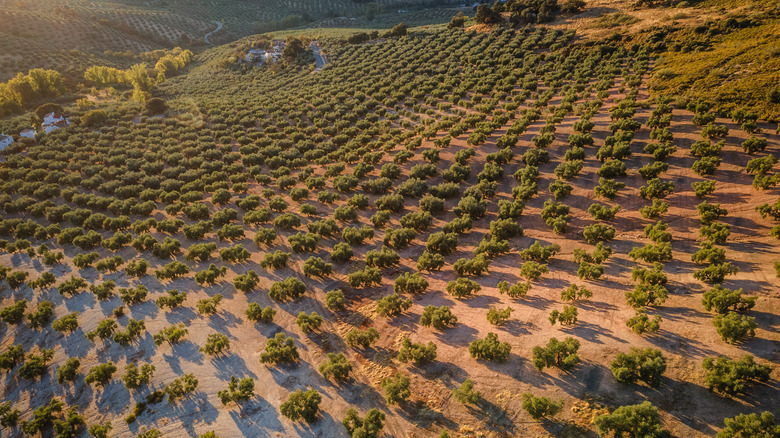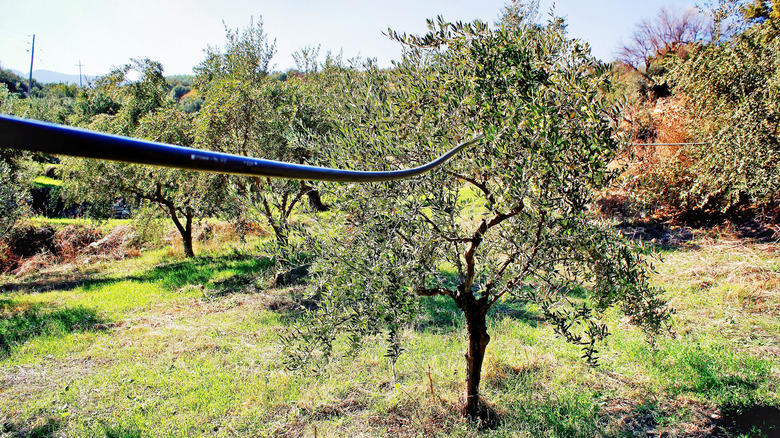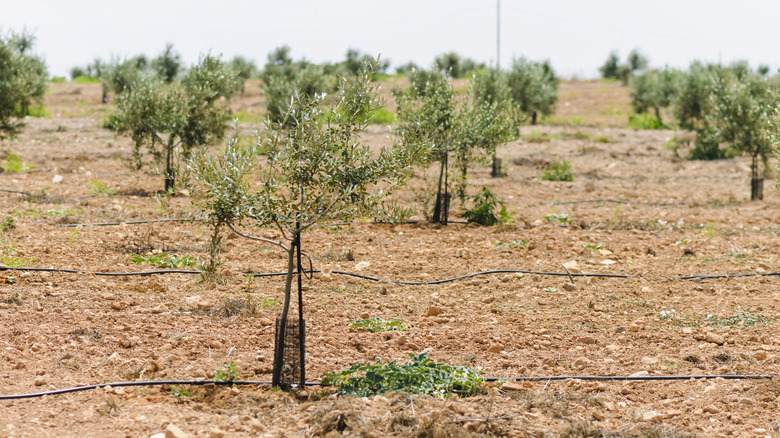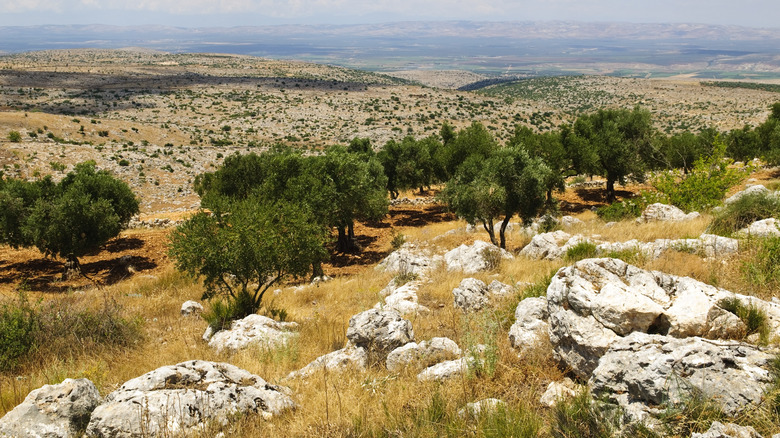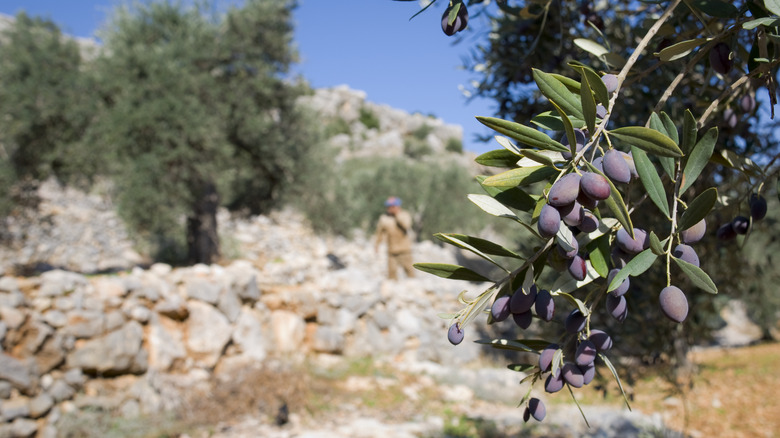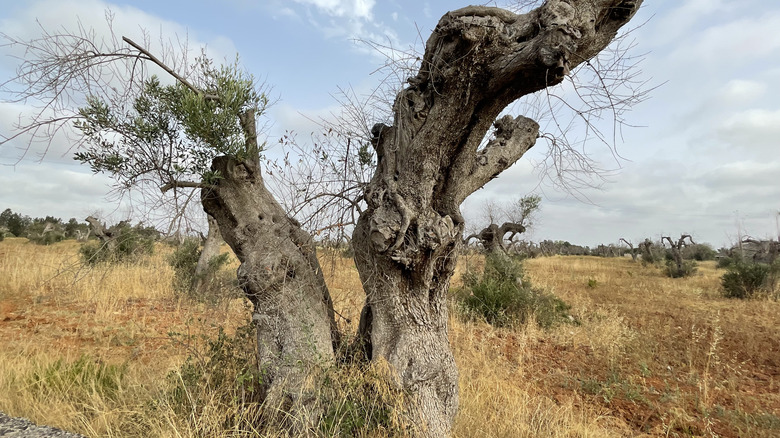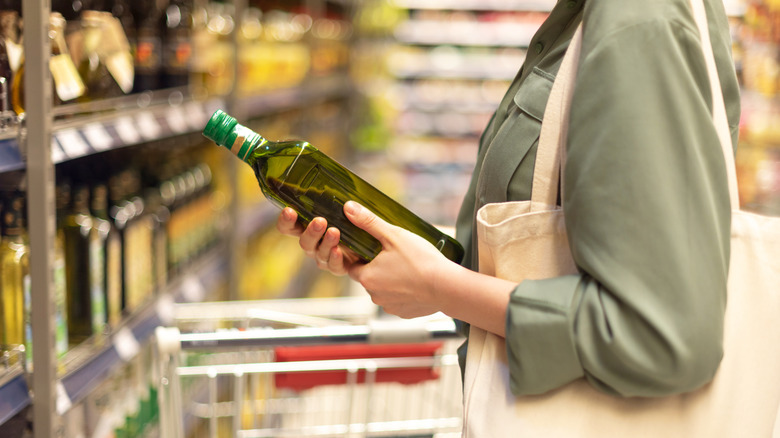The Harsh Reality Of The Olive Oil Industry
In 2023, Starbucks released its latest coffee drink, the Oleato, made with a generous spoonful of extra virgin olive oil. Unfortunately, the drink has reportedly given some people stomach issues, thanks to the combination of caffeine, a stimulant, and olive oil, a relaxant, having a laxative effect. This is, however, no fault of the oil itself, at least in terms of quality. The brand used by Starbucks is Partanna, an award-winning oil often ranked among the world's finest. With less reputable olive oil brands, however, it can be a lot harder to be certain that the oil you're buying is what it claims to be.
Olive oil is ostensibly separated into a few different grades, with the USDA using roughly the same definitions as the rest of the world. The highest grade, with its fruity aroma and taste, is extra virgin olive oil. The lowest grade isn't actually fit for human consumption without processing and is not typically used in foods. A problem lies in the fact that, in the U.S., olive oil has no national quality standard, and the FDA offers little specific guidance on the matter — despite calls for better regulation. The result is that it's surprisingly easy for fraudulent olive oil to make its way onto grocery store shelves, and even the genuine stuff may have been produced through uncomfortably shady means. Like many others, this industry hides some dark secrets.
Olive oil has a long history of fraud
Counterfeit olive oil may seem like a strange idea, but it's been a problem for far longer than you might realize. And that problem has, on occasion, been a severe one. In 2016, it was estimated that as much as 80% of the Italian olive oil on the market in the U.S. was fake. In the EU, olive oil is consistently one of the most polluted food products, with even the more expensive oils on the market sometimes being high-effort fakes. Olive oil is often adulterated with cheaper oils like sunflower or canola. The latter is especially concerning, considering that canola allergies are not uncommon.
Olive oil fraud has seemingly been a problem since ancient times, with the Romans having extensive checks to prevent oil from being stolen or counterfeited. Centuries later, in the 1990s, adulterated olive oil was the most common agricultural fraud in the EU. In 2007, according to The New Yorker, the practice was widespread enough that it began to threaten the livelihoods of honest olive growers. By the 2010s, the fraudsters were so openly adulterating oil that it sparked protests from farmers.
By far the most damaging olive oil fraud, however, happened in 1981. As Reuters reports, a batch of oil sold to the public as olive oil was actually canola oil. Even worse, this oil was intended for industrial use and had been denatured with 2% aniline, a severely toxic and potentially carcinogenic chemical. It had such harmful effects that it left 300 people dead and many others permanently disabled.
Olive oil helps fund the Mafia
Food-related fraud is often the realm of organized crime, and olive oil is a favorite target of the Mafia. Known as "agromafia" in Italy, it's a big earner, bringing in over $16 billion in 2016. The usual method, as the Olive Oil Times explains, is to blend real extra virgin olive oil with cheaper olive oil grades. The adulterated oil is then mislabelled and sold. Any farmers attempting to expose the problem are met with violence in retaliation. Much of the fake oil is sold to markets in the U.S., with one American bestseller found to be cut with lampante oil — an olive oil grade unfit for food, traditionally considered only good enough to burn in oil lamps.
In 2017, an Italian police operation broke a major Mafia ring that was shipping cheap mislabelled oil to the U.S. Unfortunately, this was seemingly only a minor setback. The following year, agromafia activities were still on the rise in Italy. As a result, per CBS, a few guidelines were released to help American consumers avoid buying poor-quality oil. Buying olive oil from California is an option, as is buying Italian oil online, direct from the producers. For oil on supermarket shelves, an important piece of advice is to check the label to look for a region known for producing olive oil, like Puglia or Sicily. Unfortunately, though, even regions like these are not guaranteed free from corruption.
Migrant workers are exploited to grow olives
Sicily produces about 10% of Italy's olive oil and is home to hundreds of presses. It's also the original home of the Mafia, and they're still active there to this day, including in a migrant camp near the town of Campobello di Mazara. According to InfoMigrants, this dangerous and unsanitary site is nestled among Sicily's olive groves, and police are afraid to set foot there. Hundreds of migrants arrive there every year, often without proper documentation, working for black market gangmasters. Frequently coming from Africa, these people compare their conditions to a form of slavery. Living areas are squalid, and they're made to work even in sweltering heat for wages that are only a fraction of the legal minimum wage. Puglia, reportedly, is home to similar migrant camps.
Migrant farm workers face similarly inhumane conditions in Spain, the world's largest olive oil producer, where they're also put to work picking other fruit such as strawberries and tomatoes. According to Ethical Consumer, there are nine basic workers' rights, and some farms in Spain frequently break eight of them. Working excessive hours in unsafe conditions, migrant workers are severely underpaid. Their wages may be refused, their passports may be confiscated, and some face sexual abuse and harassment. Workers who attempt to speak out by joining unions or going on strike are promptly and unfairly fired, making many afraid to do so.
Many European olive farmers live in poverty
Problems with exploitation in the olive oil industry don't stop with the workers. Small farms are often stricken by poverty. Spain, Italy, and Greece are major European producers of olive oil, and a European Commission Report in 2012 found that half of all specialized olive farms earned less than €10,000 per full-time working family member. Around 7% weren't even economically sustainable, making negative income. Their situation has been described as a poverty trap.
One third of the world's olive oil comes from Andalusia in Spain, where workers are in short supply. Many of their workers are migrants, and the farms often can't afford to pay them fair wages. The resulting difficulty in finding workers is part of why the olive industry is using ever more machines on farms. Recently, poor harvests have caused Spanish olive farms to struggle to remain in operation, prompting the government to take action. In 2019, AgroPopular reported that unemployment subsidies were made more easily accessible to farm workers, helping seasonal laborers absorb the financial impact of the decline in working days. Their situation remains precarious, however, as climate change threatens future harvests.
Olive farms are threatened by climate change
Shifting weather patterns caused by climate change are having pronounced effects on European farms, and olive farms are no exception. Some of the world's most prolific olive-growing regions are among the most at risk. In 2022, droughts struck vast regions of Europe, as reported by The New York Times, and some olive farms saw a drastically reduced harvest. In some cases, only about half the usual crop survived the extreme weather. With Europe producing most of the world's olive oil, these severe droughts had global consequences. With this shortage still ongoing, it's likely that olive oil will become steadily more expensive.
Climate change is threatening olive production all around the Mediterranean. In Greece, olive growers faced a threefold problem after 2021 was Europe's hottest summer on record. With the winter being warmer and dryer than usual, many trees didn't fully blossom in the springtime. For those that did, abnormally hot spring weather scorched flowers, preventing them from producing olives. The worst effects came in summer, when severe heat waves caused olives to shrivel on branches and sometimes sparked calamitous wildfires, killing thousands of trees. On the south side of the Mediterranean, olive trees in Egypt faced similar troubles, with alternating months of cool weather and sweltering heat waves causing olive harvests to be as much as 80% lower than normal.
Olive groves require a lot of water
While recent olive crops have failed all across Europe thanks to extreme weather events, other places have seen a boost as a result. Morocco currently holds a much larger share of the olive oil market, but this comes with a different problem. Per The Africa Report, Morocco is severely affected by water insecurity, a growing problem globally, and olive trees can require a lot of water to grow. Export crops in Morocco have been described as requiring "often unreasonable groundwater use," prompting some reforms to try and curb water waste by growing different crops.
Olive trees are quite resistant to drought, but more water is needed when growing the trees for their fruit. More water means not only more olives but better-quality olives, too. The driest months of the year are, understandably, when olives require the most irrigation, and according to the trade journal The Irragazette, a single tree can require 80 liters of water every day. Irrigation is particularly important for the younger olive trees in large industrial olive groves, where exposed soil means more water is lost by evaporation, so that more water is needed overall. With irrigation, a tree can start producing fruit in just five or six years, while trees left alone can take up to 15 years to start producing olives. This all means that, for multiple reasons, olive growers are incentivized to use more water for their trees.
Olive oil production has significant environmental impacts
As well as requiring lots of water, olive farming can have some detrimental effects on the local environment. According to an EU report, the most significant in Mediterranean countries is soil erosion. Olives are often farmed in areas that are more arid, and poor soil management can lead to loss of topsoil. As a result, some olive-producing areas are at risk of desertification. Another issue is water pollution caused by runoff from olive farms, closely linked to soil erosion. The chemical fertilizers and pesticides used in olive farms can pollute surface water. In some cases, this can even affect reservoirs. Drinking water has sometimes been found to contain high levels of nitrates from fertilizers.
The process of making the oil itself can further compound the problem with its own harmful waste and environmental impacts. Olive oil production creates two major waste products: the solid remains of the olives, known as olive press cake, and olive mill wastewater. The process actually creates a lot more of this waste than actual oil, and once discarded, it can damage local ecosystems by harming both plants and the bacterial communities they depend on. There's no standard way to dispose of olive waste, which means there's little regulation and no easy way to monitor any potential ecological damage. Despite being a natural product, olive wastewater can't be disposed of in regular water treatment systems and needs to be detoxified before it can be considered safe.
Syrian olive farmers suffer from oppression
In 2022, olive farmers in Syria were forced to pay levies to military forces funded by Turkey. According to the Syrian Observatory for Human Rights, tribute payments were demanded from both pressers and traders. All the while, Ankara-backed factions were also vandalizing the olive trees themselves, cutting them down to sell them for firewood. Any who refused to pay were threatened with imprisonment.
A similar situation occurred in 2019 and effectively amounted to olive oil piracy. The Syrian North Press Agency reported at the time that if any olive farmers didn't pay the money demanded, the militias simply claimed the olive harvest for themselves, cutting off a major source of income in the region. This olive oil was then sold under false pretenses to Spanish markets, with traders claiming it was produced in Turkey. The matter was further complicated by the fact that there was no easy way to analyze the oil to tell where it originated. It's impossible to know how much of the stolen Syrian olive oil was fraudulently sold this way. This wasn't the first such problem to happen in Spain; two Spanish organizations allegedly sold Tunisian olive oil while fraudulently claiming that it was produced in Spain.
Palestinian olive trees are vandalized
Olives are an essential crop in Palestine. The olive oil industry there usually makes up around 15 to 19% of the Palestinian agricultural industry, meaning that it's a vital source of income. According to the United Nations Conference on Trade and Development, around 57% of cultivated Palestinian land is used to grow olives. What's more, the trees themselves carry deep cultural significance among the Palestinian people. This led to the trees and their growers being targets of violence by Israeli settlers, further impoverishing Palestinians living in the West Bank region.
Amnesty International reported in 2019 that Palestinian farmers were frequently attacked by settlers, who also vandalized the trees that those farmers relied on for their income. This closely followed thousands of hectares of Palestinian farmland being confiscated to build new towns. Yesh Din, an Israeli human rights organization, called the area a "hotspot" for violence enacted on Palestinian villagers. In 2020, the vandalism was still ongoing, with thousands of trees destroyed over the course of the year. Per HIC-MENA, the violence intensified during the harvest season, with extremists also stealing olive oil in their raids. About 40% of new trees planted by Palestinians in 2020 were destroyed by settlers.
Olive trees are facing a plague
Alongside climate change, olive trees are facing a biological threat. A type of bacteria, Xylella fastidiosa, is causing a virulent plague in Italian olive groves, known as Olive Quick Decline Syndrome. The European Commission has highlighted this as one of the most dangerous plant pathogens in the world, ravaging olive trees and also killing off citrus trees, almond trees, and grapevines. The infection spreads quickly and kills off trees in shockingly large numbers. As well as affecting income, this comes with an emotional toll. Olive trees can live for centuries and, among olive-growing families, they're treated as heirlooms. Some farms are likely to lose every last one.
Per the Olive Oil Times, 2022 saw a major outbreak of this plague in Puglia, a region of Italy famous for its olive oil. Local authorities attempted to establish containment zones, destroying infected trees to try and prevent the disease from spreading. This may seem heavy-handed, but over the last decade, the disease has killed hundreds of thousands of Italian trees. The bacteria that causes it is difficult to contain, and it's known to infect more than 500 plant species. All around the Mediterranean, this plague has killed millions of olive trees, with scientists describing it as an ongoing ecological disaster. The bacterium itself is an invasive species, having been accidentally introduced to Europe from South America via ornamental coffee plants. Since it was first discovered, it's been labeled one of the most serious threats to world agriculture.
Olive oil on shelves may no longer be fresh
With all the concerns around the Mediterranean, American buyers might feel safer buying Californian olive oil, but this has a few problems of its own, highlighted in a 2010 report by UC Davis. Adulteration with cheaper oils and production of poor-quality oils from damaged or overripe olives were two of the issues they found, but one major one was rather more mundane: A lot of the olive oil on grocery store shelves had already gone rancid. This can be caused by a variety of different factors, including exposure to excessive light or heat, improper storage, or simply age. Like most other foodstuffs, all of these factors can cause oxidation, which will make the oil spoil.
It's easy to forget that olive oil is essentially just crushed fruit. It's a lot like fresh juice in some ways, but it's seldom treated as such. Most significantly, it has a limited shelf life, lasting around 18-24 months. Olive oil producers often keep a reserve of their stocks, in case of poor harvests or other shortfalls. This allows them to always keep supplies of oil to sell, but the downside is that some of this reserve oil may already be over a year old by the time it's eventually sold to consumers. It's always wise to check the label on the bottle to see when the olives were harvested, to make certain the oil is still fresh, and avoid clear bottles that increase the oil's exposure to light.
